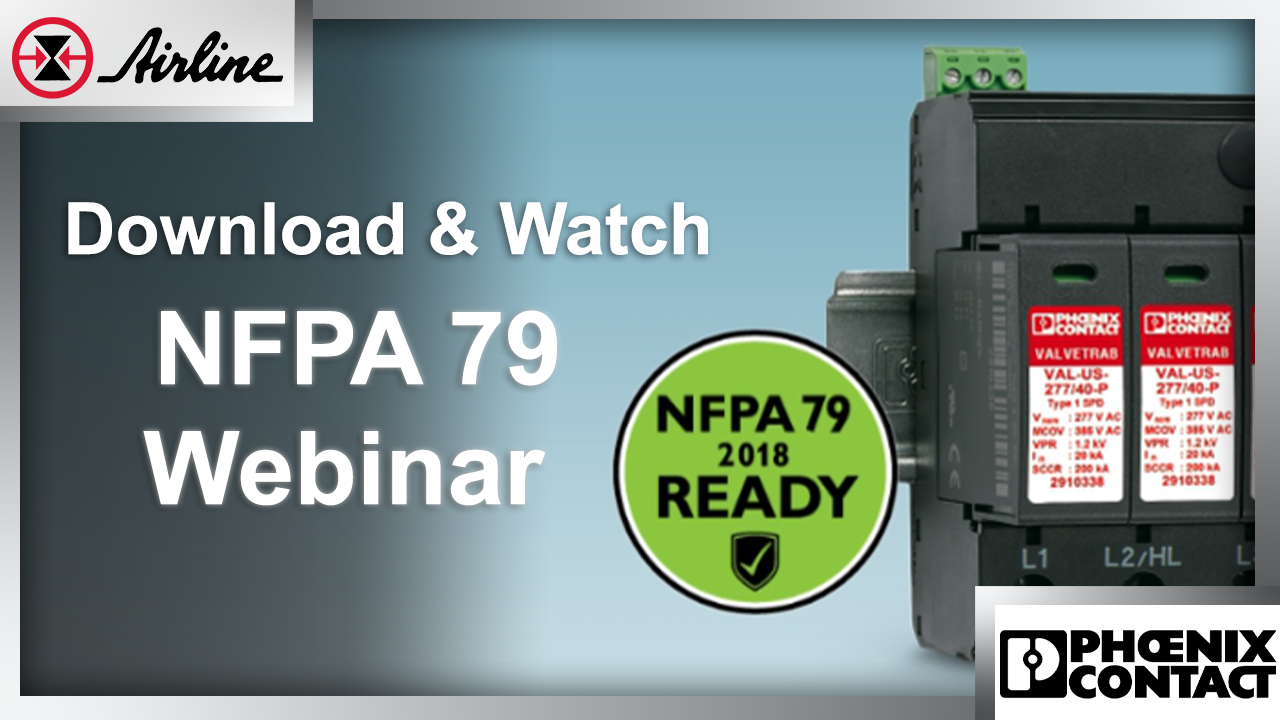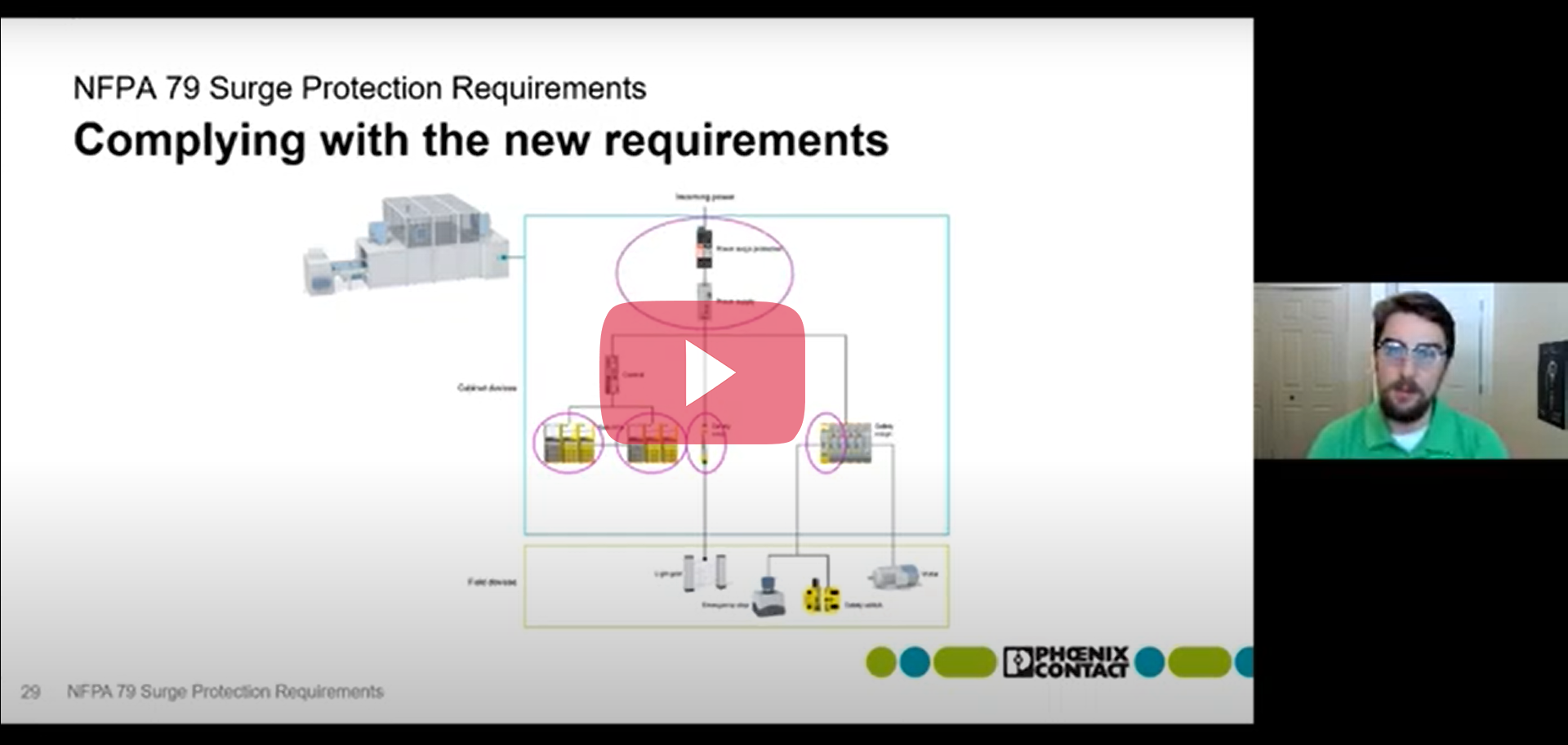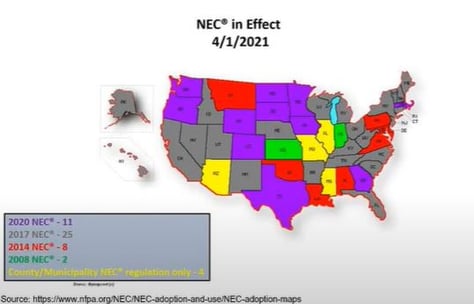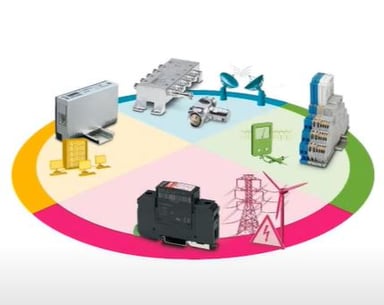To safeguard applications from surges and other risks truly, a safe work environment is needed. That’s why more and more states are incorporating wording from NFPA standards into their OSHA (Occupational Safety and Health Agencies) regulations every year. In these states, compliance with these NFPA standards is mandatory. That’s why in today’s blog post, I want to go over what the new NFPA 79 standards mean for you, your company, and how you can address it in your applications. In addition, I encourage you all to download and watch the NFPA webinar where Micah Eastie, a Power Reliability Business Development Application Engineer from Phoenix Contact, discusses the NFPA 79, 2018 surge protection standards in-depth.
Jump To Section:
Standards and Codes
Code Requirments Timeline for SPDs
Changes to NFPA 79
Complying With New Requirements
Circle of protection
Get Elite Phoenix Contact Support
Summary
Tools & Resources
Let’s Start Step-By-Step:
Standards and Codes
NEC Installation Regulation is the code you’ll often see in single-family housing on machinery floors. This code is the national electric code that regulates every electoral installation. So, when inspectors come in, whether a local inspector or some higher-up, like a county inspector, they will look for national electrical code compliance. Moreover, for installation regulation, ensure everything’s up to snuff, and any high-risk application is taken care of in the system. With this updated NFPA 79 standard, the machinery directive deals with a lot more risk mitigation.
Next is the UL 508A standard for control cabinets. A UL inspector will look specifically at the UL standard, a prevalent standard in the US for those control cabinets in many machinery applications. It’s important to note this is UL 1449 surge arrestors. Again, UL is a prevalent code in the US, and we are looking at the UL standard for these surge arrestors. The NEC and NFPA 79 codes are very heavily regulating the power side of these circuits. So, the UL 1449 standard is for those power surge arrestors, and with all these “nesting dolls” of code, these are the surge arrestors that we’ll predominantly be focusing on for this blog post
.
Code Requirments Timeline for SPDs
The NEC is revised every three years, and the first mention of installing SPD’S on some of these applications happened in 2014. Yet, In 2017, code called out many more applications, including industrial machinery, which we’re focusing on today. So, as we move forward from 2014 to 2017, these codes are only building on each other.
For example, suppose you’re in a state where NEC 2020 is starting to be enforced. In that case, you will be required to add surge arrestors to your home or system if it’s being rechecked, or in any way you’ve added an addition onto your house with more electricity, you may have a requirement to add an SPD to the application. NEC is a continually evolving standard, and states adopt NEC at different rates.
Changes to NFPA 79
NFPA publishes the NFPA 79, and it is revised every three to five years. These standards change because the NFPA takes tons of feedback from the field. They look at things like, what’s causing shocks and fires? How can we mitigate these risks? To answer these questions, they start creating loose codes based on what they see as the sources and the entry points of these hazards. As the NFPA works through these risks, they start getting stricter and stricter with them to find how the field adopts them. Installation requirements for SPD’s were the first described in the 2015 edition. However, there was no requirement to use them. This update is in NFPA 79, 2018, in article 7.8.1 SPD’s for equipment protection.
Complying With New Requirements
Before aligning with the new requirements, there are a few things you will have to define before starting.
Define the system configuration and voltage level powering your application to define what size surge protection device you’ll need to comply with new regulations. If you have the voltage configuration defined, you’re on an excellent path to compliance with this code.
The next step is to install the appropriate listed SPDs. Then install the listed SPD into the application. To determine the correct SPD to use, please see the different surge arrestor information https://bit.ly/3geekTG.
Circle of protection
The circle of protection determines if paths in or around your systems need to be protected. Therefore, it’s essential to use the process of protection concept to safeguard applications from surges and other risks truly. For example, if you are protecting a terminal block of the surge arrestor, it might be worth it; it might not be. But if you are watching a switch or controller, it may be helpful to protect those systems certainly. The goal is to have proper protection, considering all of the potential entrance points for surges. While watching the system’s mains, do not forget, that doesn’t mean you are fully protected; there could be other paths for those risks to arise. That’s why Phoenix Contact offers a variety of SPDs to lock surges out of your applications.
Get Elite Phoenix Contact Support
Airline Hydraulics is an Elite Distributor for Phoenix Contact products, meaning we offer premium support for their advanced product suite. Shop Phoenix Contact components on Airline’s website and access real-time availability from Airline or factory stock, pricing documentation, accessory items, and more.
Summary
The 2018 revision of the NFPA 79 (Article 7.8.1) standard requires surge protection in machinery that contains safety circuits.
- Many states have adopted this standard, and if they haven't - they have a roadmap of when they will adopt it. Find updated standard information here: https://www.nfpa.org/NEC/NEC-adoption-and-use/NEC-adoption-maps.
- To meet these requirements, you must use Surge Protection Devices (SPD's) that are UL Listed
- You can follow the Circle of Protection methodology (draw a circle around your device and decide where surges are most likely to enter).
- The most common use of Surge Protection to meet the NFPA 79 standard is installing surge in front of the incoming power to the machine (usually before the power supply)
- Phoenix Contact VAL-US products are UL Listed products specifically used to meet NFPA 79 regulations and meet the most commonly used voltage in the United States.
Tools & Resources
- https://info.airlinehyd.com/webinar-nfpa-79
- Phoenix NFPA 79 Landing Page: http://www.phoenixcontact.com/2018-NFPA79
- Phoenix NFPA 79 Products (VAL-US): http://www.phoenixcontact.com/VAL-US
- State by State adoption info: https://www.nfpa.org/NEC/NEC-adoption-and-use/NEC-adoption-maps
- Airline Website – Purchase Surge Protection: https://www.airlinehyd.com/category/SURGE-PROTECTION-1/4246
- NFPA 79 Design Guide: https://f.hubspotusercontent40.net/hubfs/8466844/NFPA%2079%20Guideline.pdf
- NFPA 79 Code Requirements: find a doc in HubSpot docs
- Surge Quick Reference Guide: find a doc in HubSpot docs






%20copy.png)





Leave Comment